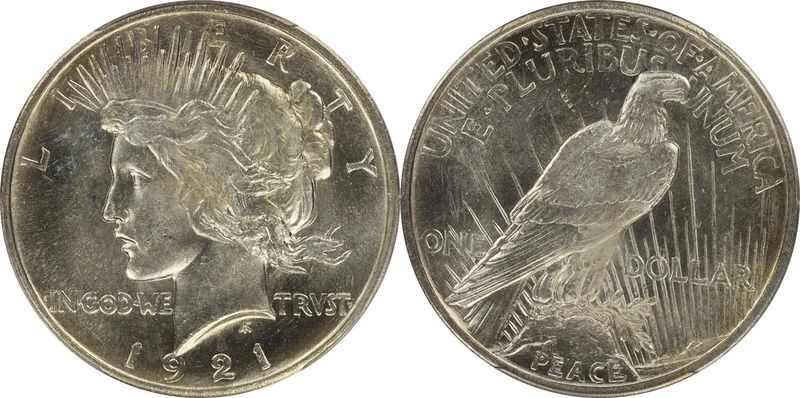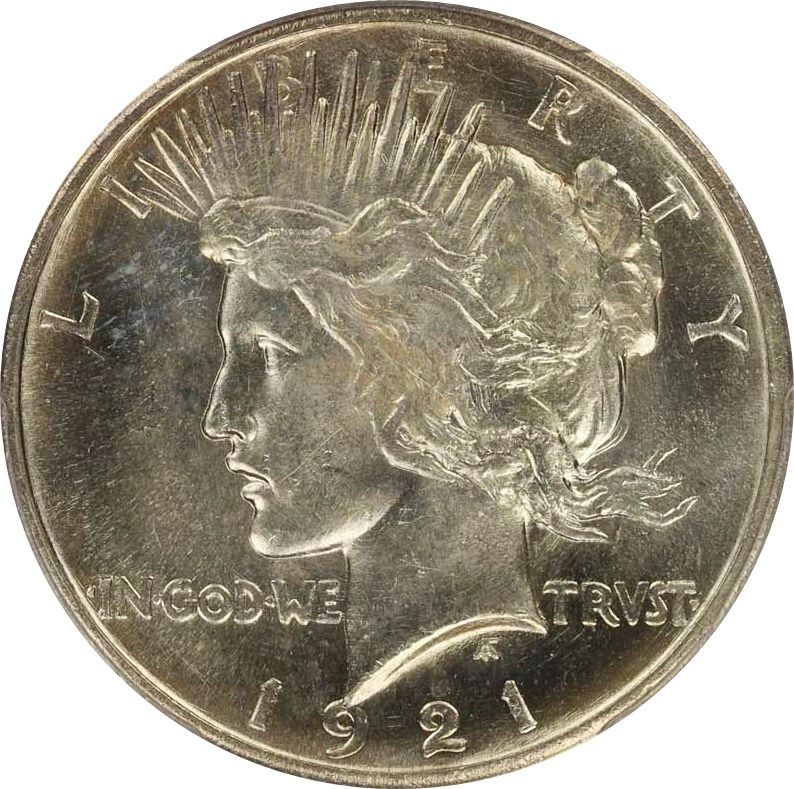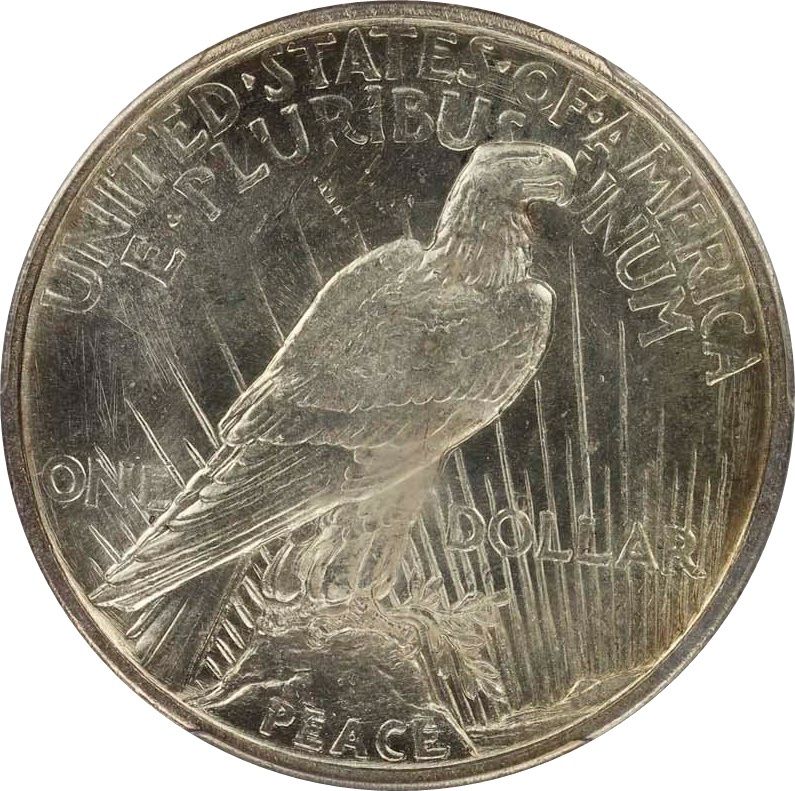1921 Peace Dollar - Glossy Luster, Strong Strike & Light Cameo Contrast
 Stuart
Posts: 9,831 ✭✭✭✭✭
Stuart
Posts: 9,831 ✭✭✭✭✭
1921 Peace Dollar - Glossy Luster, Strong Strike & Light Cameo Contrast
Judging by the Glossy Mint Luster, Strong Strike and Light Cameo Contrast this coin was more than likely one of the Early Die State coins struck on Dec 28, 1921 (1st mintage day) using the higher (150 tons per sq in) pressure. (Reference the following excerpt from Roger Burdette's - A Guide Book of Peace Dollars).
"Manufacturing standard silver dollars was hard on equipment and dies. The steel of the time could not tolerate much more than 150 tons per square inch of pressure and even that was far above the practical limit of about 120 tons.
At available pressure, the relief of central obverse and central reverse were too great to allow full metal flow into the design. The centers of the portrait and eagle are the most common places of defective detail, but problems extended to lettering, rays and other details.
When the first 1921 Peace Dollars were put into production, the engraver had pressure set well above normal in hopes of getting more detail. The designer was present on that day. But, as soon as striking began, so did the problems. The pressure was so high that steel dies failed catastrophically - they "exploded" rather than just cracking or collapsing. At the end of the day the engraver halted production, and after some tests the next day, resumed with reduced striking pressure - hence the poorly detailed coins common for 1921.
Only the first day's production were minimally acceptable to the designer or engraver. The coins with very good central detail AND fully formed letters and rays are the best that were made. Some of the pieces described as "proofs" don't have any more detail than good circulation coins and were probably not made on a medal press. - as are all proof coins of that era."



Judging by the Glossy Mint Luster, Strong Strike and Light Cameo Contrast this coin was more than likely one of the Early Die State coins struck on Dec 28, 1921 (1st mintage day) using the higher (150 tons per sq in) pressure. (Reference the following excerpt from Roger Burdette's - A Guide Book of Peace Dollars).
"Manufacturing standard silver dollars was hard on equipment and dies. The steel of the time could not tolerate much more than 150 tons per square inch of pressure and even that was far above the practical limit of about 120 tons.
At available pressure, the relief of central obverse and central reverse were too great to allow full metal flow into the design. The centers of the portrait and eagle are the most common places of defective detail, but problems extended to lettering, rays and other details.
When the first 1921 Peace Dollars were put into production, the engraver had pressure set well above normal in hopes of getting more detail. The designer was present on that day. But, as soon as striking began, so did the problems. The pressure was so high that steel dies failed catastrophically - they "exploded" rather than just cracking or collapsing. At the end of the day the engraver halted production, and after some tests the next day, resumed with reduced striking pressure - hence the poorly detailed coins common for 1921.
Only the first day's production were minimally acceptable to the designer or engraver. The coins with very good central detail AND fully formed letters and rays are the best that were made. Some of the pieces described as "proofs" don't have any more detail than good circulation coins and were probably not made on a medal press. - as are all proof coins of that era."



Stuart
Collect 18th & 19th Century US Type Coins, Silver Dollars, $20 Gold Double Eagles and World Crowns & Talers with High Eye Appeal
"Luck is what happens when Preparation meets Opportunity"
0
Comments
get. If it had a CAC bean I swear I'd pull the trigger on it. But ... with no bean. ..... maybe.... no , a pass for me.
Thank you for sharing. I enjoy your 1921's.
J
Cheers
Bob
Very nice Peace Dollar.
Fullstrike, I don't know if it's the one you mean, but DaveW had an NGC 66+ recently that I've examined in hand, and it is one impressive coin.
In the left field on the reverse, are those die polish marks? Very nice Peace Dollar.
LuckyBucks, Thanks for your above quoted post. In reply to your question, Yes those raised relief lines that you referred to in the left reverse field are die polish lines.
There are additional prominent die polish lines in the far right reverse field below the 2nd "A" in America, and also in the upper right reverse field between the letters "S" & "O" of the words "States Of".
Those die polish lines are diagnostic for this specific VAM variety.
Stuart
Collect 18th & 19th Century US Type Coins, Silver Dollars, $20 Gold Double Eagles and World Crowns & Talers with High Eye Appeal
"Luck is what happens when Preparation meets Opportunity"
Liberty: Parent of Science & Industry
What an impressive coin. So beautifully designed and when struck to this degree bordering a masterpiece. Thank you for sharing. I enjoy your 1921's. J
Relaxn, Thanks for your above quoted post about my new 1921 Peace Dollar. I appreciate everyone's comments and observations about this coin.
It's nice to see so many fellow forum members describing the Strike, Luster and Cameo contrast, and not fixate solely on numeric grade.
I'm still anxiously waiting for the VAM Attributions...
Stuart
Collect 18th & 19th Century US Type Coins, Silver Dollars, $20 Gold Double Eagles and World Crowns & Talers with High Eye Appeal
"Luck is what happens when Preparation meets Opportunity"
Stuart
Collect 18th & 19th Century US Type Coins, Silver Dollars, $20 Gold Double Eagles and World Crowns & Talers with High Eye Appeal
"Luck is what happens when Preparation meets Opportunity"
However my personal Evaluation standards focus more on Strike and Luster, as compared with the TPGS Grading standards which IMO tend to more heavily weigh Preservation State at the expense of the other two criteria.
Strike on 1921 Peace Dollars can vary on each specific coin in different device areas of the coin such as in Miss Liberty's Central Hair, her Tiara, Motto, Legend, Date, Rays and Eagle's Breast & Tail Feathers.
Stuart
Collect 18th & 19th Century US Type Coins, Silver Dollars, $20 Gold Double Eagles and World Crowns & Talers with High Eye Appeal
"Luck is what happens when Preparation meets Opportunity"
I don't care.
So what VAM is it?
It's like a bunch of little old ladies. JFC.